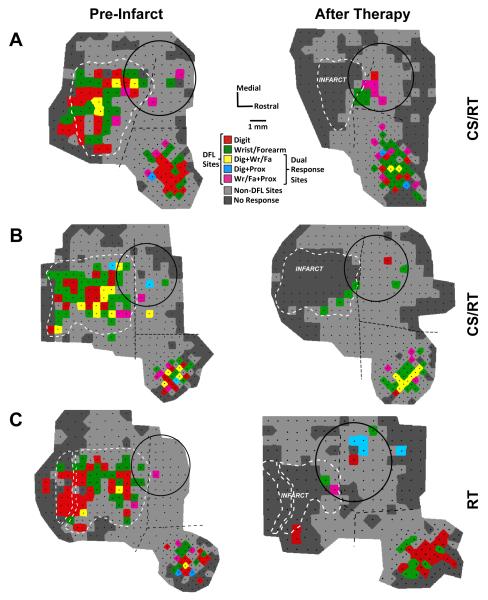Figure 5.
Representational maps from two monkeys in the CS/RT group (panels A and B) and one monkey in the RT group (panel C). Black dots indicate the location of ICMS stimulation sites in each map, and DFL sites are indicated by one of five colors (as in Figure 2). Non-DFL sites (proximal forelimb, face, etc.) are shaded light gray (rather than dark blue, as in Figure 2) to improve visibility of the DFL regions. Borders between M1, PMD, and PMV (dashed black lines) were defined in pre-infarct (baseline) maps based on ICMS data and vascular landmarks. Notably, some PMD DFL sites are often adjacent to the M1 DFL area, with as little as 500 μm separation. In post-therapy maps, the vascular landmarks from the baseline map were used to delineate the borders. Tissue necrosis of the infarct caused deformation of intact cortical tissue and surface vasculature, which is reflected by the shift in border positions in the post-therapy maps. In monkey C, the two infarct outlines indicate that a large pass-through artery was spared from occlusion (see Methods). All three subjects had near-complete loss of DFL area in M1, with a limited number of ICMS-responsive sites at the rostral edge of the infarct (consistent with prior reports and likely reflecting uneven tissue distortion between the cortical surface and deeper layers14). Movements were evoked by ICMS throughout PMD and PMV after therapy, indicating that CS did not adversely affect the physiological responsiveness of the cortical tissue. For all three subjects, the monopolar electrode was implanted 2 weeks post-infarct (shown on the pre-infarct map only for reference), and post-therapy maps were derived 7 weeks post-therapy. Image scaling for figure display is responsible for the apparent change in size of the electrode between maps (all electrode circles are 4 mm in diameter).

